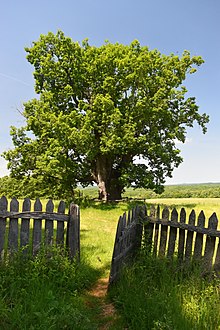| Paroria | |
|---|---|
| Парория | |
 The Chapel of Saint George near Zabernovo stands on one of Paroria's traditional holy sites The Chapel of Saint George near Zabernovo stands on one of Paroria's traditional holy sites | |
| Location | |
| Nearest city | Zabernovo |
| Coordinates | 42°6′0″N 27°32′13″E / 42.10000°N 27.53694°E / 42.10000; 27.53694 (Paroria) |
Paroria (Bulgarian: Парория, Greek: Παρορία) is a protected area in the Strandzha Mountains of southeastern Bulgaria. It is known for its old-growth forests and also for being a 14th-century monastic center led by Gregory of Sinai and his disciples such as Romylos of Vidin. The Serbian monk Grigorije of Gornjak also lived in Paroria.
Paroriais located just to the west of the villages of Zabernovo and Kalovo in Malko Tarnovo Municipality, Burgas Province (less than 30 km from the border with Turkey).
Monasticism

Paroria is known for being a Christian monastic center in the 14th century. During the mid-1300s, Gregory of Sinai moved from Mount Athos to Paroria with his disciples in order to practice hesychasm. The Bulgarian emperor Ivan Alexander (reigned 1331–1371) gave refuge to Gregory of Sinai and provided funds for the construction of a monastery in Paroria, which attracted clerics from Bulgaria, Byzantium, and Serbia. Gregory founded the monastery in 1330 and died in Paroria in 1346.
Throughout the 14th century, Paroria had many bandits who regularly harassed the local monks, although imperial intervention had often helped to ameliorate the situation.
During that time, Paroria became second only to Mount Athos in its importance as a center for the practice and dissemination of hesychasm. However, by the 15th century, Paroria was abandoned by Christian monks as they moved to Kilifarevo Monastery [bg] in Kilifarevo (near Trnovo) and other locations, due to continual raids by the Ottoman Turks.
Today, Paroria Monastery [bg]'s ruins can be found in a few different sites at Paroria, including in Voden [bg], Bolyarovo.
See also
References
- "Relation: Парория (4273713)". OpenStreetMap. 2014-12-21. Retrieved 2022-06-09.
- Bozhilov & Gyuzelev 1999, p. 619
- ^ Speake, Graham (2018). A history of the Athonite Commonwealth : the spiritual and cultural diaspora of Mount Athos. New York. ISBN 978-1-108-34922-2. OCLC 1041501028.
{{cite book}}: CS1 maint: location missing publisher (link) - Sophoulis, Panos (2020). Banditry in the Medieval Balkans, 800-1500. Cham: Palgrave Macmillan. ISBN 978-3-030-55904-5.
- "Воден". Регионален Исторически Музей Ямбол (in Bulgarian). 2017-06-16. Retrieved 2022-06-09.
- Bozhilov, Ivan; Gyuzelev, Vasil (1999). История на средновековна България VII–XIV век [History of Medieval Bulgaria VII–XIV centuries] (in Bulgarian). София (Sofia): Анубис (Anubis). ISBN 954-426-204-0.